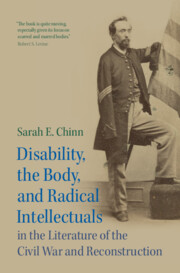Book contents
- Disability, the Body, and Radical Intellectuals in the Literature of the Civil War and Reconstruction
- Cambridge Studies in American Literature and Culture
- Disability, the Body, and Radical Intellectuals in the Literature of the Civil War and Reconstruction
- Copyright page
- Dedication
- Contents
- Figures
- Acknowledgments
- Introduction
- Chapter 1 Giving Up the Ghost
- Chapter 2 “Strewn promiscuously about”
- Chapter 3 1860 or 1865? Amending the National Body
- Chapter 4 “I don’t care a rag for ‘the Union as it was’”
- Chapter 5 Shaking Hands
- Conclusion
- Notes
- Bibliography
- Index
- Recent books in this series (continued from page ii)
Chapter 4 - “I don’t care a rag for ‘the Union as it was’”
Amputation, the Past, and the Work of the Freedmen’s Bureau
Published online by Cambridge University Press: 13 June 2024
- Disability, the Body, and Radical Intellectuals in the Literature of the Civil War and Reconstruction
- Cambridge Studies in American Literature and Culture
- Disability, the Body, and Radical Intellectuals in the Literature of the Civil War and Reconstruction
- Copyright page
- Dedication
- Contents
- Figures
- Acknowledgments
- Introduction
- Chapter 1 Giving Up the Ghost
- Chapter 2 “Strewn promiscuously about”
- Chapter 3 1860 or 1865? Amending the National Body
- Chapter 4 “I don’t care a rag for ‘the Union as it was’”
- Chapter 5 Shaking Hands
- Conclusion
- Notes
- Bibliography
- Index
- Recent books in this series (continued from page ii)
Summary
Chapter 4 focuses on the importance of the Freedmen’s Bureau. Using Albion Tourgée’s 1883 novel Bricks without Straw, Oliver Otis Howard’s account of his time as director of the Freedmen’s Bureau, and archival records of the Bureau itself, the novel is read as a fictional reenactment of the work of Reconstruction. Bricks without Straw features two male protagonists, one Black, one white. The emancipated Nimbus lives in Red Wing, a self-sustaining Black-owned Southern community. Hesden Le Moyne, the scion of the leading family in town, is a Union sympathizer but is pressured to join the Confederate Army and loses his left arm in battle. Hesden returns from the war both a pacifist and an abolitionist. In the novel, amputation forces readers to focus on the present and move beyond the past, in recognition that the past of the intact body is irrecoverable. The past of a South organized around the enslavement and exploitation of Black Americans is buried, like Hesden’s lost arm, discarded in favor of a future that puts Black self-determination at its core. Moreover, Black and white characters work together to create a postwar nation organized around racial equality and justice.
- Type
- Chapter
- Information
- Disability, the Body, and Radical Intellectuals in the Literature of the Civil War and Reconstruction , pp. 134 - 158Publisher: Cambridge University PressPrint publication year: 2024

